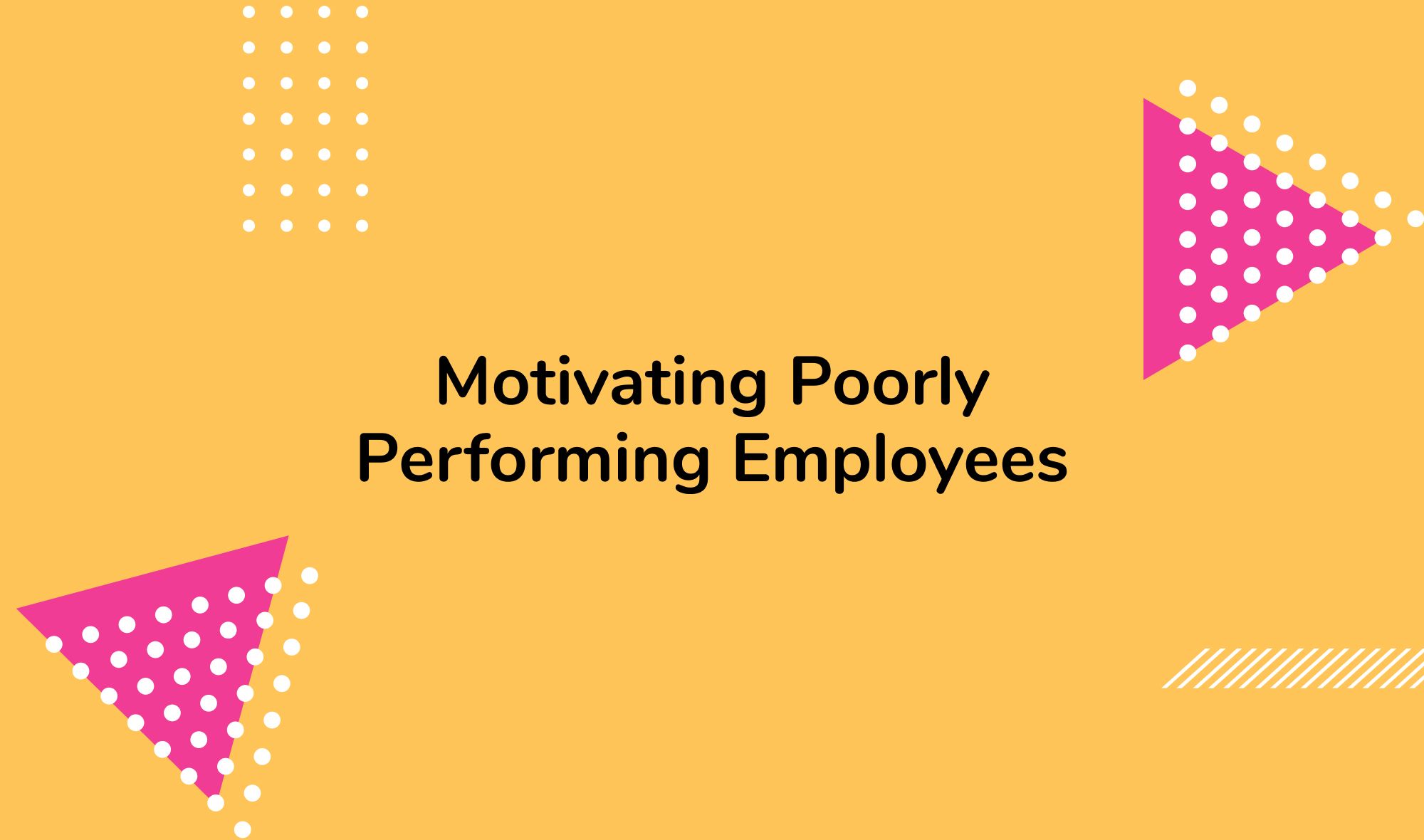How to Tackle Poor Performance at Work: A Manager's Guide
By Marco Franzoni • July 13, 2023
Key Takeaways
- Understanding what constitutes poor performance is key.
- Management plays a crucial role in addressing and handling poor performance.
- Coaching and motivation are powerful tools to improve performance.
- The journey from poor to power performance requires a strategic and thoughtful approach.

In the intricate tapestry of the modern workplace, individual threads - the employees, play a pivotal role. Their output, engagement, and overall performance construct the complex patterns that either enhance or dull the vibrancy of an organization. However, at times, certain threads lose their strength, resulting in poor performance. As an underpinning factor, it's crucial to address this issue effectively. But before we begin tackling it, let's understand what we mean by 'poor performance'.
In essence, poor performance refers to a situation where an employee or a team fails to meet the standards or expectations set for their role. This underperformance can manifest in missed deadlines, subpar quality of work, low engagement, or a decline in productivity. These performance problems not only affect the employee in question but also have a ripple effect on the entire team, causing a slowdown in work processes, lowering morale, and even impacting the organization's bottom line.
To manage these issues, we first need to identify their causes. Are they linked to personal issues, lack of motivation, or perhaps a gap in skills or resources? Whatever the reasons, pinpointing and addressing them is a vital step in improving poor performance.
This blog post delves into the multifaceted aspects of poor performance in the workplace. It explores how to recognize the signs of underperformance, outlines the management's role in tackling this issue, and shares practical steps to guide an underperforming employee or team back onto the path of high productivity and quality work.
Join our Newsletter
Transform your career with our personal growth insights. Get one valuable tip right in your inbox every Saturday morning.
Understanding Poor Performance at Work
Poor performance at work is a multifaceted issue that can stem from a myriad of factors. However, to manage these problems effectively, we first need to understand what constitutes poor performance.
What Constitutes Poor Performance?
In its simplest form, poor performance, or underperforming, refers to a failure to meet established standards, targets, or expectations relevant to the job. These standards could be tied to the quality of work produced, deadlines met, or overall engagement and productivity levels.
Notably, there's a crucial difference between poorly performing tasks and poor employee performance.
Poorly Performing Tasks vs Poor Employee Performance
Poorly performing tasks are assignments or jobs that are not up to the mark. They might be incomplete, riddled with errors, or delivered late. These tasks, while they indicate a problem, don't necessarily point to an underperforming employee. There could be external factors at play, such as unclear instructions, lack of resources, or unreasonable deadlines.
On the other hand, poor employee performance is when an employee consistently fails to meet their job expectations. This may manifest in various ways, such as regular late submissions, low-quality output, disengagement from team activities, or consistently needing supervision or corrections. This trend generally indicates deeper performance problems that need to be addressed.
Causes of Poor Performance
Understanding the causes of poor performance is crucial to addressing it. Factors contributing to poor performance can range from personal issues, such as health or family problems, to professional challenges, including lack of skills, inadequate training, or low motivation.
Understanding poor performance and identifying its root causes are critical first steps in improving an underperforming employee's output. By addressing these issues, management can guide their team member back on track, enhance workplace productivity, and foster a more engaged and successful team.
Identifying Signs of Poor Performance

Early detection can make a world of difference when it comes to managing poor performance. It's not always a straightforward task to discern the symptoms of underperformance, but learning to recognize them can be the first step in turning things around.
Some key signs of poor performance can include a drop in productivity, missed deadlines, or a decrease in the quality of work. However, these are often the symptoms of a deeper issue. It's also essential to pay attention to less obvious signs such as a lack of engagement, diminished enthusiasm, or changes in behavior. For example, if an ordinarily punctual employee starts coming in late or missing days, or if a team member who usually produces top-quality work begins turning in subpar assignments, these could be signs of poor performance.
Why is early identification important? By recognizing these signs before they escalate, you create the opportunity to intervene and provide the necessary support to get your team member back on track. This is crucial for maintaining the overall health and productivity of your team, as well as for the individual's professional development. Learn more about how to identify and address self-sabotaging behavior which could be impacting performance.
Consider the story of 'Sarah', a manager at a mid-sized tech firm. Sarah noticed that one of her top-performing engineers, 'John', started falling behind in his tasks. Instead of dismissing this as a temporary slump, Sarah recognized this as a potential sign of poor performance. She decided to address the situation early, opening a dialogue with John to understand the reasons behind his sudden drop in productivity. As it turns out, John was facing challenges in his personal life that were impacting his work. By identifying this early, Sarah was able to provide the necessary support and adjustments to help John improve his performance, averting a larger issue down the line.
Remember, the key to managing poor performance effectively is not just about recognizing the signs, but also understanding the underlying factors. In the next section, we'll explore various causes of poor performance and how you, as a manager, can address them.
Addressing Poor Performance: Management's Role

It's vital to understand that as a manager, your role goes beyond just identifying underperformance - you also hold the key to managing and even reversing it. By leveraging your leadership skills, providing effective supervision, and adopting a coaching mindset, you can successfully navigate performance problems in your team.
Leadership is about more than just authority; it's about guiding your team through challenges and fostering an environment that encourages growth and development. It's your responsibility as a leader to create a workplace culture that promotes productivity and engagement, and that includes taking proactive steps to address poor performance.
Supervision is equally critical. As a supervisor, you need to keep a pulse on your team's work and their performance. Regular check-ins, feedback sessions, and performance reviews can help you catch and address performance issues early, before they escalate into larger problems.
Moreover, managers can effectively tackle poor performance by embracing the role of a coach. Coaching isn't about telling your employees what to do; it's about supporting them in finding their own solutions and strategies for improvement. This involves guiding your team members, providing constructive feedback, and helping them develop their skills and capabilities. Zellalife's guide to effective sales management provides more insights into how to use coaching and other techniques to drive performance improvement.
One resource that provides practical advice on leadership in complex situations is the book "Lead When Your Boss Can't". The book explores the dynamics of leadership, including how to motivate and inspire your team in situations where you may not have full authority. It's a valuable read for any manager grappling with performance problems and looking for actionable strategies to handle them.
Remember, managing poor performance isn't just about identifying the problems - it's about actively taking steps to foster improvement and productivity. In the next section, we'll delve deeper into practical strategies and solutions for tackling poor performance.
Practical Steps for Managing Poor Performance

When it comes to poor performance, it's crucial to have both proactive and reactive strategies in place. While reactive strategies will help you manage existing performance issues, proactive measures can prevent underperformance from becoming a persistent problem.
Here are some practical steps you can take to tackle poor performance:
Proactive Measures
- Set Clear Expectations: Be explicit about your expectations regarding tasks and assignments. Provide detailed job descriptions and define performance standards.
- Provide Regular Feedback: Regularly review your team members' work and provide constructive feedback to help them improve.
- Invest in Training and Development: Equip your team with the skills and knowledge they need to perform their roles effectively.
Leadership development programs often include team coaching as part of their curriculum. For those transitioning into first-time managerial roles, you might find our guide on First-time Manager Training to be particularly useful.
Reactive Measures
- Identify the Problem: The first step in handling an underperforming employee is to identify the performance issue. Use data and observable behaviors to pinpoint the problem.
- Open Dialogue: Have an open and honest conversation with the employee about their performance. Be objective, empathetic, and open to their perspective.
- Implement a Performance Improvement Plan: Based on the identified issues, develop a tailored improvement plan. Regularly follow up on the plan's progress and provide necessary support.
- Monitor Progress: Continually assess the employee's performance and provide feedback. Recognize improvements and continue to address areas that need more work.
Keith Cunningham's book "The Road Less Stupid" provides great insights on how to avoid common business mistakes and make more informed decisions, which can be extremely helpful when dealing with performance problems. His advice can guide you through the process of addressing, confronting, and resolving performance issues more effectively.
Remember, managing poor performance isn't just about dealing with the problem at hand - it's about creating an environment that encourages ongoing improvement, engagement, and high-quality work. Stay tuned for our next section where we discuss how to boost motivation as a means to improve performance.
The Power of Coaching in Handling Poor Performance

Coaching is an often-underutilized tool in managing and improving poor performance. When an employee is underperforming, providing them with individualized coaching can help identify and address the root causes of their issues. This support goes beyond mere performance management—it enables growth, development, and long-term improvement.
Here's how coaching can help:
- Identify Underlying Issues: Coaches can help pinpoint specific areas where an employee is struggling, whether it's a skills gap, motivation issue, or personal problem.
- Create a Personalized Improvement Plan: Once the issues have been identified, a coach can work with the employee to develop a tailor-made plan for improvement.
- Provide Ongoing Support: Coaches offer regular feedback, encouragement, and guidance, which are crucial for sustaining improvement over time.
- Build Confidence and Skills: Through coaching, employees can gain new skills, enhance their existing ones, and build the confidence needed to perform at their best.
As mentioned in the insightful book "Great Work", by David Sturt and Todd Nordstrom, coaching can be a transformative tool that allows employees to better understand their work and how they can contribute more effectively.
Moreover, it's important to distinguish between coaching and mentoring. While both are important, they serve different purposes. Coaching typically involves short-term, performance-focused development, while mentoring focuses on long-term career development and personal growth.
Our Coaching Vs. Mentoring blog provides a more in-depth exploration of these distinct roles, also check out our article on Business Coach and Mentor: What Is The Difference?.
To ensure that you are using the most effective coaching strategy for your team, we recommend reading our ultimate guide on the types of coaching in the workplace.
If you're interested in diving deeper into the multitude of coaching styles, our 15 Types of Coaching Inside and Outside The Workplace post is a must-read.
Motivating Poorly Performing Employees

Motivation is a powerful tool in any manager's arsenal, and when used correctly, it can be instrumental in improving an employee's performance. An underperforming employee may be lacking motivation, and it's up to leadership to spark that drive and inspiration.
Here are some strategies to motivate and inspire your underperforming employees:
- Set Clear Expectations: Make sure employees understand their roles, responsibilities, and what is expected of them.
- Offer Constructive Feedback: Provide regular, constructive feedback. Make sure to focus not only on areas for improvement but also recognize their strengths and achievements.
- Create a Supportive Environment: Fostering a positive workplace culture that encourages teamwork, cooperation, and mutual respect can have a significant impact on an employee's motivation levels.
- Provide Incentives: Tangible rewards for improved performance can be a great motivation. However, remember that not all incentives need to be monetary. Recognition, additional responsibilities, or opportunities for professional development can also act as strong motivators.
- Encourage Participation: When employees feel that their voice matters and their contributions are valued, their motivation and performance levels can significantly improve. Learn more about this approach in our article about The Power of Participation.
Motivation is not a one-size-fits-all solution. It requires understanding the unique needs, desires, and aspirations of each employee. By tailoring your approach to each individual's motivations, you can inspire them to overcome their performance issues and reach their full potential.
Stay tuned for the final section, where we'll explore the ultimate goal: transforming poor performance into exceptional productivity.
From Poor to Power Performance: The Transformation Journey

The journey from poor to power performance may seem arduous, but it's possible with the right strategies and mindset. Let's delve into how you can take an underperforming team member and turn them into an exceptional asset to your team.
- Identify Performance Issues: As we discussed earlier, the first step is identifying the signs of poor performance. Recognize the difference between a poorly performing task and a pattern of underperformance in an employee.
- Understand the Causes: After identifying the problem, explore the causes behind it. Are there personal issues affecting their work? Are there clear performance objectives? Understanding the reasons behind poor performance can help create a tailored improvement plan.
- Address the Performance Issues: Once the issues and causes have been identified, it's time to address them. This step requires honest conversations, constructive feedback, and the laying out of a plan for improvement.
- Implement Coaching: Engage with your underperforming employee through coaching, guiding, and supporting them. Encourage their strengths, help them overcome their weaknesses, and make them feel valued.
- Motivate and Encourage: Keep their spirits high during this transformation journey. Motivation, recognition, and incentives play a significant role in improving performance.
A great example of this transformation journey can be seen in the book "Unstoppable Teams". The author shares real-life experiences about how leadership and teamwork transformed underperforming units into high-performance teams.
Remember, the transformation journey is not a sprint but a marathon. It requires patience, perseverance, and a firm belief in your team's potential. With these strategies, you can help turn poor performance into powerful productivity. The journey may be challenging, but the results are well worth the effort.
Stay tuned for our conclusion, where we will summarize key takeaways and present our final thoughts on managing poor performance in the workplace.
Conclusion
In conclusion, tackling poor performance is a task every manager will face at some point in their careers. It's important to remember that the presence of underperforming team members is not a reflection of your abilities as a leader. Rather, how you manage and address these performance issues truly showcases your leadership skills and influences organizational culture.
In this post, we've covered the key aspects of managing poor performance, starting from understanding what it means and identifying its signs. We've also discussed the critical role of management in handling poor performance and the practical steps that can be taken to address it. We dove into the power of coaching in improving performance and the transformative role motivation can play.
The journey from poor to power performance is not a straightforward one, but with the right approach, it's certainly achievable. Whether you're a seasoned manager or just stepping into the role, we hope these insights prove helpful in your management journey.
If you're facing performance problems in your team, don't hesitate to seek assistance. At Zellalife, we offer a comprehensive business coaching service that can help you navigate these challenges with ease.
Lastly, we'd love to hear from you. Share your experiences and strategies in handling poor performance in the comments below. Or perhaps you've read a book that has been instrumental in transforming your team's performance? We'd be excited to hear about that, too. Remember, we're all learning and growing together in this management journey.
To express your appreciation for a job well done, visit our 100 Ways to Express Gratitude post for valuable insights.
Stay tuned for more insightful content around employee performance, productivity, and more on the Zellalife blog.
Happy managing!
Additional Resources
To learn more about developing executive presence, check out our blog post on Executive Presence: The One Leadership Quality No One Told You About.
To further enhance your organization's growth and success, consider leveraging the expertise of middle managers and understanding their vital role in organizations.
Additionally, you might find our detailed post on how to choose the perfect coach for executives beneficial for your search.
Read more about: Professional Development, Executive Coaching, Employee Experience